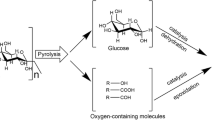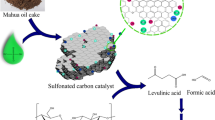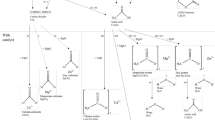Abstract
This study investigates the impact of NaF/Al2O3 catalysts on hydrothermal liquefaction (HTL) of cellulose. Three catalysts with varying NaF loadings were synthesized and characterized using XRD, FT-IR, BET, SEM, SEM–EDX, and SEM–EDS. HTL reactions were conducted at 300, 325, and 350 °C for 30 min. Elemental, GC–MS, FT-IR and 1H NMR analyses were performed on the liquid products. Results reveal that NaF/Al2O3 catalysts effectively enhance liquid product yield and generate high-energy-value products. NaF-2 and NaF-3 exhibit superior performance in fuel-specific liquid product yield, with increased aliphatics and reduced oxygen compounds. These catalysts display higher carbon content, lower oxygen-to-carbon ratios, and higher heating values, suggesting the production of bio-oils with favorable fuel properties and superior energy values. The findings contribute to understanding catalyst performance in biomass liquefaction, informing efforts to enhance process efficiency and sustainability. Optimum HTL conversion of cellulose occurs with 30% NaF loading.
Graphical Abstract









Similar content being viewed by others
References
Aysu T, Durak H (2016) Bio-oil production via catalytic supercritical liquefaction of Syrian mesquite (Prosopis farcta). J Supercrit Fluids 109:26–34. https://doi.org/10.1016/J.SUPFLU.2015.11.002
Park Y-K, Jun BR, Park SH et al (2014) Catalytic conversion of cellulose over mesoporous Y zeolite. J Nanosci Nanotechnol 14:5120–5123
Durak H (2014) Bio-oil production from Glycyrrhiza glabra through supercritical fluid extraction. J Supercrit Fluids 95:373–386. https://doi.org/10.1016/j.supflu.2014.08.009
Sınağ A, Yumak T, Balci V, Kruse A (2011) Catalytic hydrothermal conversion of cellulose over SnO2 and ZnO nanoparticle catalysts. J Supercrit Fluids 56:179–185. https://doi.org/10.1016/j.supflu.2011.01.002
Genel S, Durak H, Durak ED, et al (2023) Hydrothermal liquefaction of biomass with molybdenum, aluminum, cobalt metal powder catalysts and evaluation of wastewater by fungus cultivation. Renew Energy 203:20–32. https://doi.org/10.1016/j.renene.2022.12.030
Yin S, Tan Z (2012) Hydrothermal liquefaction of cellulose to bio-oil under acidic, neutral and alkaline conditions. Appl Energy 92:234–239. https://doi.org/10.1016/j.apenergy.2011.10.041
Xu C, Lad N (2008) Production of Heavy Oils with High Caloric Values by Direct Liquefaction of Woody Biomass in Sub/Near-critical Water. Energy Fuels 22:635–642. https://doi.org/10.1021/ef700424k
Gao Y, Wang X-H, Yang H-P, Chen H-P (2012) Characterization of products from hydrothermal treatments of cellulose. Energy 42:457–465. https://doi.org/10.1016/j.energy.2012.03.023
Yin S, Mehrotra AK, Tan Z (2012) Direct formation of gasoline hydrocarbons from cellulose by hydrothermal conversion with in situ hydrogen. Biomass Bioenergy 47:228–239. https://doi.org/10.1016/j.biombioe.2012.09.038
Sasakı M, Hayakawa T, Araı K, Adschırı T (2003) Measurement Of The Rate Of Retro-Aldol Condensatıon Of D-Xylose In Subcrıtıcal And Supercrıtıcal Water. In: Hydrothermal Reactions and Techniques. World Scıentıfıc, pp 169–176
Zhao H, Holladay JE, Brown H (1979) Zhang ZC (2007) Metal Chlorides in Ionic Liquid Solvents Convert Sugars to 5-Hydroxymethylfurfural. Science 316:1597–1600. https://doi.org/10.1126/science.1141199
Wang Y, Deng W, Wang B et al (2013) Chemical synthesis of lactic acid from cellulose catalysed by lead(II) ions in water. Nat Commun 4:2141. https://doi.org/10.1038/ncomms3141
Xu Z-X, Cheng J-H, He Z-X, et al (2019) Hydrothermal liquefaction of cellulose in ammonia/water. Bioresour Technol 278:311–317. https://doi.org/10.1016/j.biortech.2019.01.061
de Caprariis B, Scarsella M, Bavasso I et al (2021) Effect of Ni, Zn and Fe on hydrothermal liquefaction of cellulose: Impact on bio-crude yield and composition. J Anal Appl Pyrolysis 157:105225. https://doi.org/10.1016/J.JAAP.2021.105225
Hirano Y, Miyata Y, Taniguchi M, et al (2020) Fe-assisted hydrothermal liquefaction of cellulose: Effects of hydrogenation catalyst addition on properties of water-soluble fraction. J Anal Appl Pyrolysis 145:104719. https://doi.org/10.1016/j.jaap.2019.104719
Wang G, Zhang J, Yu J, et al (2022) Catalytic hydrothermal liquefaction of sewage sludge over alumina-based and attapulgite-based heterogeneous catalysts. Fuel 323:124329. https://doi.org/10.1016/j.fuel.2022.124329
Pongsiriyakul K, Kiatkittipong W, Adhikari S, et al (2021) Effective Cu/Re promoted Ni-supported γ-Al2O3 catalyst for upgrading algae bio-crude oil produced by hydrothermal liquefaction. Fuel Processing Technology 216:106670. https://doi.org/10.1016/j.fuproc.2020.106670
Murugan C, Bajaj HC, Jasra RV (2010) Transesterification of Propylene Carbonate by Methanol Using KF/Al2O3 as an Efficient Base Catalyst. Catal Letters 137:224–231. https://doi.org/10.1007/s10562-010-0348-6
Alper K, Tekin K, Karagöz S (2019) Hydrothermal Liquefaction of Lignocellulosic Biomass Using Potassium Fluoride-Doped Alumina. Energy Fuels 33:3248–3256. https://doi.org/10.1021/acs.energyfuels.8b04381
Wan B, Li W, Sun W, et al (2020) Synthesis of Cryolite (Na3AlF6) from Secondary Aluminum Dross Generated in the Aluminum Recycling Process. Materials 13:. https://doi.org/10.3390/ma13173871
Wang L, Wang C, Yu Y, et al (2012) Recovery of fluorine from bastnasite as synthetic cryolite by-product. J Hazard Mater 209–210:77–83. https://doi.org/10.1016/j.jhazmat.2011.12.069
Chen J-Y, Lin C-W, Lin P-H, et al (2014) Fluoride recovery from spent fluoride etching solution through crystallization of Na3AlF6 (synthetic cryolite). Sep Purif Technol 137:53–58. https://doi.org/10.1016/j.seppur.2014.09.019
He J, Li Y, Xue X et al (2017) Leaching of fluorine and rare earths from bastnaesite calcined with aluminum hydroxide and the recovery of fluorine as cryolite. RSC Adv 7:14053–14059
Zhang Y-X, Jia Y (2016) Fluoride adsorption onto amorphous aluminum hydroxide: Roles of the surface acetate anions. J Colloid Interface Sci 483:295–306. https://doi.org/10.1016/j.jcis.2016.08.054
Damayanti NP (2010) Preparation of superhydrophobic PET fabric from Al2O3–SiO2 hybrid: geometrical approach to create high contact angle surface from low contact angle materials. J Solgel Sci Technol 56:47–52. https://doi.org/10.1007/s10971-010-2271-0
Jozanikohan G, Abarghooei MN (2022) The Fourier transform infrared spectroscopy (FTIR) analysis for the clay mineralogy studies in a clastic reservoir. J Pet Explor Prod Technol 12:2093–2106. https://doi.org/10.1007/s13202-021-01449-y
Akhtar J, Amin NAS (2011) A review on process conditions for optimum bio-oil yield in hydrothermal liquefaction of biomass. Renew Sustain Energy Rev 15:1615–1624. https://doi.org/10.1016/J.RSER.2010.11.054
Abu El-Rub Z, Bramer EA, Brem G (2004) Review of Catalysts for Tar Elimination in Biomass Gasification Processes. Ind Eng Chem Res 43:6911–6919. https://doi.org/10.1021/ie0498403
Yu Y, Lou X, Wu H (2008) Some Recent Advances in Hydrolysis of Biomass in Hot-Compressed Water and Its Comparisons with Other Hydrolysis Methods. Energy Fuels 22:46–60. https://doi.org/10.1021/ef700292p
Sugano M, Takagi H, Hirano K, Mashimo K (2008) Hydrothermal liquefaction of plantation biomass with two kinds of wastewater from paper industry. J Mater Sci 43:2476–2486. https://doi.org/10.1007/s10853-007-2106-8
Kumar M, Olajire Oyedun A, Kumar A (2018) A review on the current status of various hydrothermal technologies on biomass feedstock. Renewable and Sustainable Energy Reviews 81:1742–1770. https://doi.org/10.1016/j.rser.2017.05.270
Zhang B, He Z, Chen H, et al (2018) Effect of acidic, neutral and alkaline conditions on product distribution and biocrude oil chemistry from hydrothermal liquefaction of microalgae. Bioresour Technol 270:129–137. https://doi.org/10.1016/j.biortech.2018.08.129
Jensen CU, Rodriguez Guerrero JK, Karatzos S et al (2017) Fundamentals of HydrofactionTM: Renewable crude oil from woody biomass. Biomass Convers Biorefin 7:495–509. https://doi.org/10.1007/s13399-017-0248-8
Shah AA, Sharma K, Haider MS et al (2022) The Role of Catalysts in Biomass Hydrothermal Liquefaction and Biocrude Upgrading. Processes. https://doi.org/10.3390/pr10020207
Cao L, Zhang C, Chen H, et al (2017) Hydrothermal liquefaction of agricultural and forestry wastes: state-of-the-art review and future prospects. Bioresour Technol 245:1184–1193. https://doi.org/10.1016/j.biortech.2017.08.196
Durak H, Genel S (2020) Catalytic hydrothermal liquefaction of lactuca scariola with a heterogeneous catalyst: The investigation of temperature, reaction time and synergistic effect of catalysts. Bioresour Technol 309:123375. https://doi.org/10.1016/j.biortech.2020.123375
Acknowledgements
This research was supported by the Van Yuzuncu Yil University Research Fund. (No. FBA-2020-9228).
Author information
Authors and Affiliations
Corresponding author
Additional information
Publisher's Note
Springer Nature remains neutral with regard to jurisdictional claims in published maps and institutional affiliations.
Supplementary Information
Below is the link to the electronic supplementary material.
Rights and permissions
Springer Nature or its licensor (e.g. a society or other partner) holds exclusive rights to this article under a publishing agreement with the author(s) or other rightsholder(s); author self-archiving of the accepted manuscript version of this article is solely governed by the terms of such publishing agreement and applicable law.
About this article
Cite this article
Durak, H., Genel, S. Hydrothermal Liquefaction of Cellulose in the Presence of Sodium Fluoride-Doped Alumina Catalyst. Catal Lett 154, 1336–1350 (2024). https://doi.org/10.1007/s10562-023-04498-6
Received:
Accepted:
Published:
Issue Date:
DOI: https://doi.org/10.1007/s10562-023-04498-6




